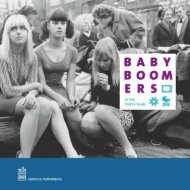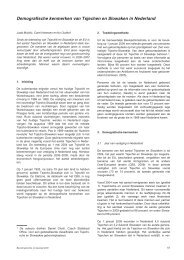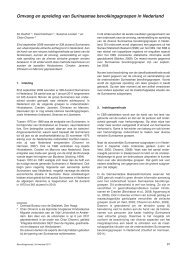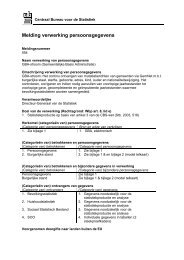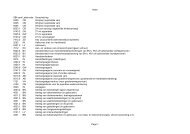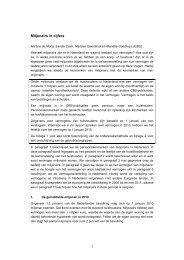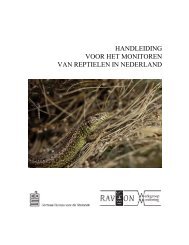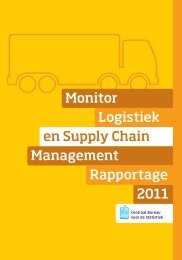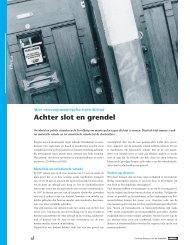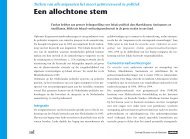Methoden voor de berekening van de emissies door mobiele ... - CBS
Methoden voor de berekening van de emissies door mobiele ... - CBS
Methoden voor de berekening van de emissies door mobiele ... - CBS
You also want an ePaper? Increase the reach of your titles
YUMPU automatically turns print PDFs into web optimized ePapers that Google loves.
INTRODUCTION<br />
The sources that cause emissions of environmental pollutants can roughly be divi<strong>de</strong>d into stationary<br />
and mobile sources. Examples of stationary sources are installations for generating heat and energy,<br />
such as central heating systems and electrical power plants, and installations where all kinds of<br />
industrial processes take place. Mobile sources inclu<strong>de</strong> various means of transport such as passenger<br />
cars, light and heavy duty trucks, inland waterway vessels and aircraft, as well as mobile machinery<br />
with combustion engines, such as agricultural tractors and forklifts.<br />
This report <strong>de</strong>scribes the methodologies, emission factors and rele<strong>van</strong>t activity data that are used to<br />
calculate the emissions of environmental pollutants from mobile sources in the Netherlands. The<br />
emissions are calculated annually by the Task Force on Transportation of the Dutch Pollutant and<br />
Transfer Register (PRTR). The resulting emission figures for greenhouse gases are reported annually<br />
in the National Inventory Report, whereas the air polluting emissions are reported in the Informative<br />
Inventory Report. Both reports also give a brief <strong>de</strong>scription of the trends in emissions and the<br />
methodologies used to calculate emissions. These methodologies and un<strong>de</strong>rlying data are <strong>de</strong>scribed<br />
in more <strong>de</strong>tail in the present report.<br />
The present report <strong>de</strong>scribes the methodologies used for calculating the emissions for the 1990-2010<br />
time series that are published in 2012 and reported in the 2012 National Inventory Report (Van <strong>de</strong>r<br />
Maas et al., 2012) and the 2012 Informative Inventory Report (Jimmink et al., 2012). This report has<br />
been compiled by the members of the Task Force on Transportation of the PRTR, which inclu<strong>de</strong>s<br />
members of Statistics Netherlands, the PBL Netherlands Environmental Assessment Agency, the<br />
Netherlands Organisation of Applied Scientific Research TNO and the RWS Centre for Transport and<br />
Navigation (DVS) of the Dutch Ministry of Infrastructure and the Environment. For a more general<br />
<strong>de</strong>scription of the Dutch PRTR and the different task forces, please refer to the website of the PRTR<br />
(www.emissieregistratie.nl).<br />
The majority of the tables accompanying this report have been inclu<strong>de</strong>d in a separate Excel file.<br />
References to these tables are printed in italics. In addition to the data for the emission calculation, the<br />
tables also contain references and hyperlinks to the un<strong>de</strong>rlying data sources and data used for the<br />
calculation of the 2010 emission figures.<br />
Source categories and emission processes<br />
One of the first steps in <strong>de</strong>veloping a methodology for estimating the emissions from mobile sources is<br />
making an inventory of the various mobile sources. In broad terms, the following mobile source<br />
categories are distinguished:<br />
Road transport<br />
Railways<br />
National and international inland shipping (including recreational crafts)<br />
Maritime shipping<br />
Fisheries<br />
Civil aviation<br />
Non road mobile machinery (tractors, bulldozers, forklifts etc.)<br />
Military shipping and aviation<br />
For each source category, various emission processes are distinguished:<br />
Combustion of motor fuels for propulsion;<br />
Evaporation of motor fuels from the fuel system of vehicles;<br />
Wear of tyres, brake linings and road surfaces due to road traffic;<br />
Leakage and consumption of motor oil;<br />
Wear of overhead contact lines and carbon brushes on trains, trams and metros;<br />
Support processes on board ships (heating, electricity generation, refrigeration and pumping).<br />
9



